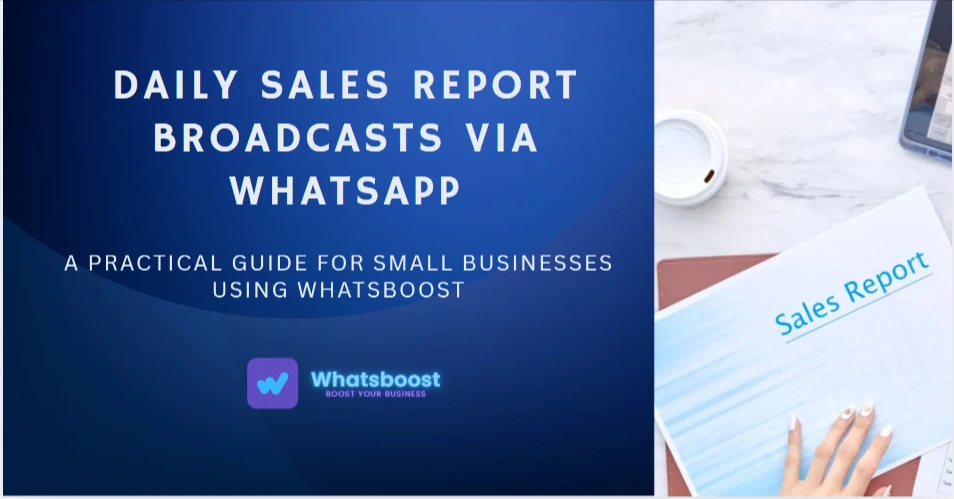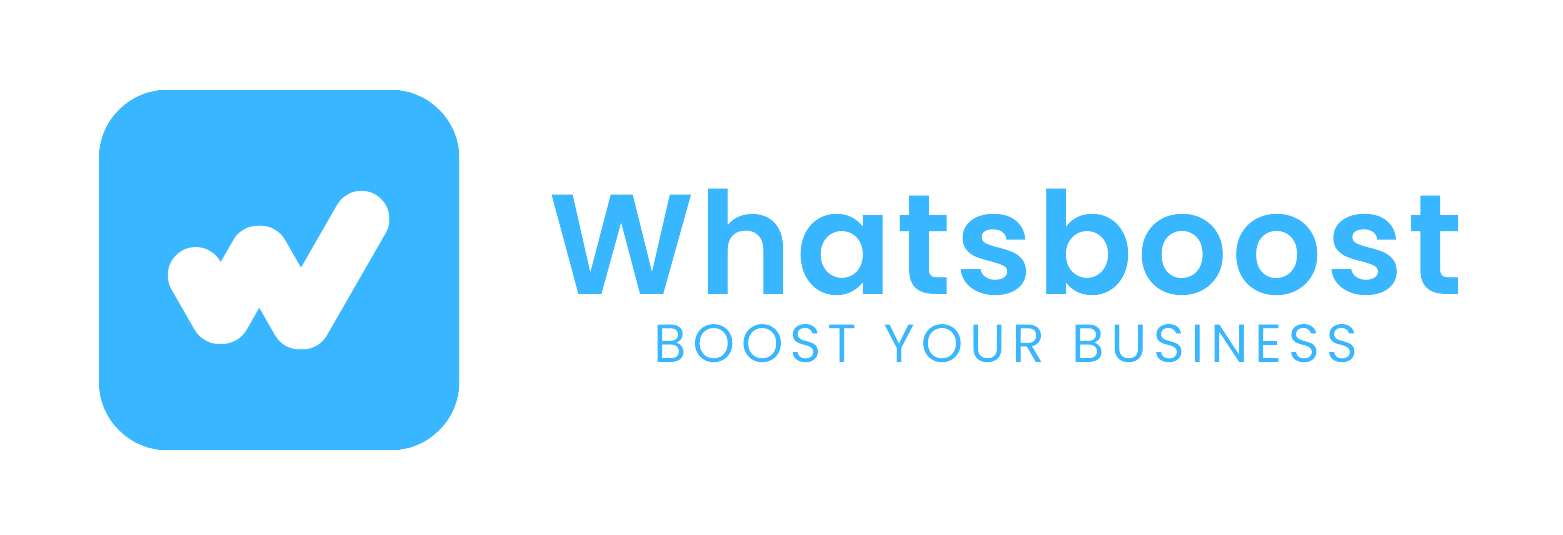
Daily Sales Report Broadcasts via WhatsApp: A Practical Guide for Small Businesses Using WhatsBoost
Learn how small businesses and service providers can automate daily sales summaries using Google Sheets and WhatsApp—delivered in real time through WhatsBoost’s browser-based connectors. A practical guide to streamlining reporting without complex APIs.
In fast-moving business environments, timely access to sales data isn’t just helpful—it’s essential. Whether you're a solopreneur managing client bookings, a service provider tracking daily transactions, or a small team coordinating across departments, having a clear picture of your sales performance helps you make better decisions, faster.
Traditionally, sales reports are emailed, printed, or reviewed in dashboards. But for many small businesses, WhatsApp has become the default communication channel. It’s where teams talk, clients ask questions, and updates are shared. So why not deliver your daily sales reports directly to WhatsApp?
This article explores how businesses can automate daily WhatsApp sales updates using Google Sheets and WhatsBoost Connectors—without relying on complex APIs or technical setups. We’ll walk through the logic, setup, and use cases, and offer practical insights for integrating this workflow into your operations.
📊 Why Daily Sales Updates Matter
Before diving into the technical setup, let’s understand the value of daily sales broadcasts:
- Real-time visibility: Knowing how much revenue was generated today helps you adjust marketing, inventory, or staffing decisions.
- Team alignment: Sales updates shared with team members keep everyone focused on performance goals.
- Client transparency: For service providers or agencies, sharing daily progress with clients builds trust and accountability.
- Error detection: Spotting anomalies early—like missing transactions or duplicate entries—prevents bigger issues later.
For small businesses, these benefits are amplified because decisions are often made quickly and with limited data. A daily WhatsApp summary can be the difference between reacting late and responding in real time.
🔗 The Tools: Google Sheets + WhatsBoost
To automate daily sales broadcasts, you need two core tools:
1. Google Sheets
This is your data source. Whether you manually enter sales, sync them from a POS system, or collect them via forms, Google Sheets acts as a flexible, cloud-based ledger.
2. WhatsBoost Connectors
WhatsBoost is a browser-based automation tool that connects WhatsApp Web to external platforms like Google Sheets. It allows you to send WhatsApp messages based on triggers—such as a new row added, a specific time of day, or a change in data.
Unlike Meta’s official WhatsApp API, WhatsBoost doesn’t require approval, coding, or server hosting. It’s designed for small businesses that need automation without complexity.
⚙️ How It Works: The Technical Logic
Let’s break down how daily sales report broadcasts function using WhatsBoost and Google Sheets.
Step 1: Structure Your Google Sheet
Create a spreadsheet with columns like:
- Date
- Transaction ID
- Customer Name
- Product/Service
- Amount
- Payment Status
Each row represents a sale. You can add formulas to calculate daily totals, averages, or category breakdowns.
Step 2: Define the Trigger
Using WhatsBoost’s integration logic, set a trigger to send a WhatsApp message at a specific time each day (e.g., 6:00 PM). The trigger can be based on:
- A new row added (for real-time updates)
- A scheduled time (for daily summaries)
- A change in a summary cell (e.g., total sales amount)
Step 3: Compose the Message
WhatsBoost allows you to create dynamic message templates using data from your sheet. For example:
📈 Daily Sales Summary – Oct 20
Total Sales: ₹42,300
Transactions: 17
Top Product: Digital Marketing Audit
Pending Payments: ₹6,500
Let’s keep the momentum going!
This message can be sent to:
- A WhatsApp group (e.g., your internal team)
- Individual team members
- Clients or stakeholders (if relevant)
Step 4: Automate the Broadcast
Once configured, WhatsBoost will send the message automatically each day. You can customize the format, recipients, and even attach files or charts if needed.
🧠 Use Cases for Different Business Types
Let’s explore how this setup benefits various small business models:
🛠️ Service Providers
A plumbing company tracks daily job completions and payments. At the end of each day, the owner receives a WhatsApp summary showing:
- Number of jobs completed
- Total revenue
- Outstanding invoices
This helps them plan routes, follow up on payments, and manage staff schedules.
🎓 Coaches & Educators
An online tutor logs session bookings and payments in Google Sheets. Each evening, they receive a WhatsApp update showing:
- Number of sessions held
- Total earnings
- Cancellations or reschedules
This supports better time management and client communication.
📈 Freelancers & Consultants
A digital marketer tracks campaign performance and client billing. Their daily WhatsApp report includes:
- New leads generated
- Billable hours
- Pending client approvals
This keeps them organized and proactive with follow-ups.
🛍️ Retail & E-commerce
A boutique owner logs in-store and online sales. Their WhatsApp summary includes:
- Total revenue
- Best-selling items
- Inventory alerts
This helps with restocking decisions and promotional planning.
🧪 Tips for Effective Implementation
To get the most out of daily WhatsApp sales updates, consider the following:
1. Keep Messages Concise
WhatsApp is a mobile-first platform. Avoid long paragraphs—use bullet points, emojis, and clear formatting.
2. Use Conditional Logic
Only send messages if certain thresholds are met (e.g., more than 5 transactions, revenue above ₹10,000). This avoids unnecessary noise.
3. Segment Recipients
Not everyone needs the same report. Use WhatsBoost’s routing features to send tailored updates to different groups.
4. Visualize Trends
Consider attaching a small chart or image showing performance trends. WhatsBoost supports media attachments for richer communication.
5. Audit Your Sheet Regularly
Ensure your Google Sheet is clean, accurate, and well-structured. Automation is only as good as the data it pulls from.
⚖️ Comparing Alternatives
Let’s briefly compare this setup with other methods of sharing sales reports:
| Method | Pros | Cons |
|---|---|---|
| Email Reports | Detailed, formal | Often ignored or delayed |
| Dashboard Tools | Interactive, visual | Requires login, not mobile-friendly |
| WhatsApp via WhatsBoost | Instant, mobile-native, automated | Limited formatting options |
| Manual WhatsApp Messages | Personal, flexible | Time-consuming, error-prone |
For small businesses, WhatsApp broadcasts strike a balance between speed, simplicity, and relevance.
🧭 Final Thoughts: Making Sales Data Actionable
Sales data is only useful if it’s seen, understood, and acted upon. By integrating Google Sheets with WhatsApp using tools like WhatsBoost, small businesses can turn raw numbers into real-time insights—shared where decisions are made.
This approach doesn’t require coding, approvals, or expensive software. It’s a practical, scalable way to keep your team informed, your clients engaged, and your operations aligned.
Whether you’re tracking daily revenue, monitoring team performance, or managing client projects, WhatsApp sales broadcasts offer a smart solution for staying on top of your business—one message at a time.
